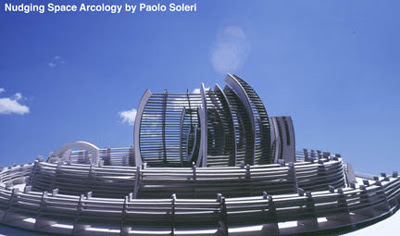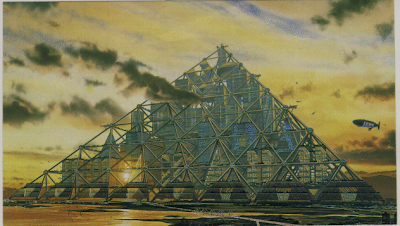
:: Arcosanti, Sky Suite - image via NY Times
Not being one to back down from parsing some new (or old) component of the lexicon, I felt as if some further definition and investigation were in order. To start, via Wikipedia: "Arcology, from the words "ecology" and "architecture," is a set of architectural design principles aimed toward the design of enormous habitats (hyperstructures) of extremely high human population density. These largely hypothetical structures, which are themselves commonly referred to as "arcologies," would be self-contained, contain a variety of residential and commercial facilities, minimize individual human environmental impact, and possibly be economically self-sufficient."
Soleri is definitely the most vocal proponent of Arcology and still active in preparing visions, such as a World Trade Center ideas for NY City, as well as the Nudging Space Arcology, both of which provide visions of Arcology in action (or at least paper).

:: WTC NYC Proposal - image via Arcosanti

:: Nudging Space Arcology - image via Arcosanti
This portmanteau of architecture and ecology (really, how can resist a phrase such as that) definitely strikes a chord with my investigations of my concurrent conconcotion of vegitecture and it's all of it's related ilk. These arcologies definitely have a good amount of relation to some of the recent works of mega-towers and city-scale ecoplanning... and I guess time will tell how much is hypothesis and how much turns into reality. Some precedents recently include Foster's Masdar City and the Crystal Island in Moscow, the recent Ultima Tower and even the 1 Billion Dollar Tishman Speyer NYC development recently announced which all have elements of ecology woven into the architecture on a grand scale.

:: Tishman Speyer NYC - image via WAN
More from Soleri, via the Arcosanti website: "In nature, as an organism evolves it increases in complexity and it also becomes a more compact or miniaturized system. Similarly a city should function as a living system. Arcology, architecture and ecology as one integral process, is capable of demonstrating positive response to the many problems of urban civilization, population, pollution, energy and natural resource depletion, food scarcity and quality of life. Arcology recognizes the necessity of the radical reorganization of the sprawling urban landscape into dense, integrated, three-dimensional cities in order to support the complex activities that sustain human culture. The city is the necessary instrument for the evolution of humankind."

:: images via Arcosanti
Some further explanation via Arcosanti site:
"The Hyper Building is an Arcology. In an Arcology, architecture and ecology come together in the design of the city. Arcology is the implosion of the flat megalopolis, the modern city of today, into a dense, complex, urban environment which rises vertically. ... The concept of a one-structure system is not incidental to the organization of the city, but central to it. Such an urban structure hosts life, work, education, culture, leisure, and health in a dense, compact system which also puts the untouched open countryside at the fingertips of the residents. The compactness of an Arcology gives 90 percent more land to farming and conservation than today's urban and suburban sprawl. This compactness makes an Arcology a more workable system. ...The automobile divides a city by scattering it across the landscape. Greater attention is given to human scale in an Arcology. In it the pedestrian reigns. Distances are measured by walks and minutes. Within it the automobile is nonsensical. ...In an Arcology energy is used more efficiently than in a conventional modern city. Pollution is a direct function of wastefulness, not efficiency. The increase in efficiency and reduction of wastefulness means a reduction of pollution. ...One role of the three dimensional city is to stop the spreading out of suburbia and its pernicious effects: hyper-consumption, segregation, waste, pollution, and ecological catastrophe. Therefore we must consider not only this initial Hyper-Building: future developments in the area must be considered. All developments surrounding the Hyper-Building must be Arcological. ...For reasons of economy, to do more with less, life is always framed three-dimensionally. This imperative can be referred to as the Urban Effect. Since the Hyper-Building is emblematic of the Urban Effect, it is not just an expedient though indispensible proposition: its stands for the ontological dynamics of life itself."

:: image via Arcosanti
An interesting theoretical idea is the section on the Arcosanti site 'Arcology Theory' which journeys Soleri's theoretical expositions and the Arcological Hyper Building Design Parameters... which provides additional information from concept to execution.

:: Concept of Hyper Building - image via Arcosanti
And while I slowly dig through the literature on this site, I come back to another burning question - what is the elusive Sim-City/Arcology connection? A post in Unsought Input from 2007 'Sim City Arcologies are Becoming a Reality' mentions this same question, and also mentions the utopic and perhaps impossible Shimzu TRY 2004 Mega-City Pyramid as an example of modern hyperstructure development, at least making me feel less crazy about thinking of the prophecy of video games. Another example, more real and perhaps big but less arcologic is Burj Dubai - which in my opinion is just big phallic oneupsmanship.
I definitely buy the concept - but there are a number of Ecotopia viewpoints that sound great on paper. I wonder how (1) this is not just another utopian vision, and 2) is this an applicable and viable theoretical framework for some of the building that is going up, either in theory, paper, or in reality? One issue is that big does not nessarily equal arcological. It must include some integration between systems and buildings, back to our previous base definition, these must be: "self-contained, contain a variety of residential and commercial facilities, minimize individual human environmental impact, and possibly be economically self-sufficient."
In this case Masdar, Dongtan, Ras Al Khaimah and other eco-cities are attempting to do this by aiming at high goals for sustainable communities on a grand scale. In another case Yeang's bioclimatic skyscrapers are attempting to take these concepts to new heights and make them more integrated, thus minimizing inputs and impacts. With an addition of vertical farming, wind generation, solar, and voila, were' getting somewhere in the vicinity of tall, self-sufficient, low-impact structures.
The real question as always: Is this a utopia that people would want to live in?

No comments:
Post a Comment